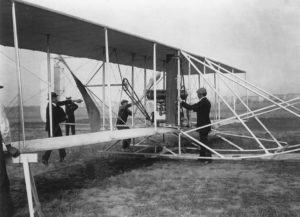
It has hard to tell where you are going if you do not know where you have been. The FAA has kicked on National Aviation History Month that runs for the month of November.
To kick off our celebration of National Aviation History Month, here’s a brief history of the FAA . For U.S. aviators – manned and unmanned alike – the FAA is a critical partner in operations. Ever thought that the concept of managing low altitude airspace was new to the unmanned industry, or that the FAA’s incredible safety history a given? Here are a few interesting picks from the FAA article:
“The modern age of powered flight began in 1903 when Orville Wright made the first sustained, powered flight on December 17 in a plane he and his brother Wilbur built. This twelve-second flight led to the development of the first practical airplane in 1905 and launched worldwide efforts to build better flying machines.”
“Pilots flew 200 to 500 feet above ground so they could navigate by roads and railways. Low visibility and night landings were made using bonfires on the field as lighting. Fatal accidents were routine.”
The commercial airline industry got started later – in 1925, when an FAA act supported the commercial passenger service with the Air Mail Act of 1925. “…airline companies such as Pan American Airways, Western Air Express, and Ford Air Transport Service began scheduled commercial passenger service. By the mid-1930s, the four major domestic airlines that dominated commercial travel for most of the 20th century began operations: United, American, Eastern, and Transcontinental and Western Air (TWA).”
Those initial commercial efforts led to the development of air traffic control. “As air travel increased, some airport operators, hoping to improve safety, began providing an early form of air traffic control (ATC) based on visual signals. Early controllers stood on the field and waved flags to communicate with pilots. Archie League, the system’s first flagmen, began work in the late 1920s at the airfield in St. Louis, Missouri.”
As has happened in the unmanned industry, stakeholders in the early manned aviation industry came to government to ask for clear standards, which the FAA delivered in 1926. “Aviation industry leaders believed the airplane could not reach its full commercial potential without federal action to improve and maintain safety standards. At their urging, the Air Commerce Act was passed in 1926. This landmark legislation charged the Secretary of Commerce with fostering air commerce, issuing and enforcing air traffic rules, licensing pilots, certifying aircraft, establishing airways, and operating and maintaining aids to air navigation. A new Aeronautics Branch in the Department of Commerce assumed primary responsibility for aviation oversight, and William P. MacCracken, Jr., became its first director.”
The history of the FAA and the development of the commercial manned aircraft industry is encouraging for the unmanned industry, as they show the development of regulations and standards that have led to the incredible safety record and vast infrastructure of the manned aircraft industry as we know it today. Check out the FAA website for more cool information about the National Aviation History Month, and share our history with the young aviators you know..
CEO DroneLife.com, DroneRacingLife.com, and CMO of Jobfordrones.com. Principle at Spalding Barker Strategies. Has enjoyed working with and around the commercial drone industry for the last 10 years. Attendance and speaker at Industry Events such as Commercial UAV, InterGeo, Interdrone and others. Proud father of two. Enjoys karate, Sherlock Holmes, and interesting things. Subscribe to all things drone at DroneLife here. Email is Harry@dronelife.com. Make Sure that you WhiteList us in your email to make sure you get our Newsletter. Editor1@dronelife.com.